Mexican cuisine is renowned for its bold and vibrant flavours, and cheese plays a significant role in many traditional dishes. From the fresh, crumbly Queso Fresco to the rich, buttery Queso Oaxaca, Mexican cheeses come in a variety of textures and flavours. In this post, we’ll explore the rich history and diverse range of Mexican cheeses, from the well-known favourites to the lesser-known regional specialties.
SEE ALSO: Our 10 best cheeses to top your nachos with →
History of cheesemaking in Mexico
During the colonial period, European settlers introduced cheesemaking techniques and ingredients to Mexico. In fact, this included the use of rennet to coagulate milk and the addition of salt to preserve cheese. This led to the development of Mexican cheeses such as Queso Blanco and Oaxaca.
In the 20th century, industrialisation and modernisation brought new changes to Mexican cheesemaking. Large-scale factories began producing processed cheeses, and new technologies allowed for the creation of cheeses with longer shelf lives and more consistent quality.
Today, Mexico has a rich and diverse cheesemaking culture, with a wide variety of traditional and modern cheeses produced throughout the country. Some of these cheeses have even gained international recognition and are enjoyed by cheese lovers around the world.
Mexico’s cheesemaking regions

Without a doubt, cheesemaking in Mexico is heavily influenced by the country’s geography and climate. Different regions of Mexico have distinct cheesemaking traditions and produce unique styles of cheese. Let’s have a look at some examples.
Central Highlands
In the central highlands of Mexico, cheesemakers use cow’s milk to produce fresh cheeses like Queso Fresco and Queso Panela. Presently, this region produces a combination of cheeses made using local traditions and recipes brought by European migrants.
Oaxaca
In the southern state of Oaxaca, cheesemakers produce a variety of unique cheeses, including the famous Quesillo (Queso Oaxaca). This stringy pasta filata cheese is made from cow’s milk and its recipe was brought to the region by Italian Dominican monks.
Chihuahua
Finally, in the northern state of Chihuahua, local artisans produce a variety of cheeses using the milk of local goats and cows. One of the most famous cheeses from this region is Queso Chihuahua (also known as Queso Menonita), a mild, smooth cheese similar to Monterey Jack.
Overall, the geography of Mexico plays an important role in the country’s cheesemaking traditions, with each region producing cheeses that reflect the local climate, landscape, and culinary traditions.
Our 10 most authentic Mexican cheeses
So, let’s now have a look at 10 of the very best Mexican cheeses. Our list will include the four cheeses that currently hold an IMPI Marca Colectiva. This is the Mexican equivalent to Europe’s AOP and the UK’s PDO.
1 Queso Fresco
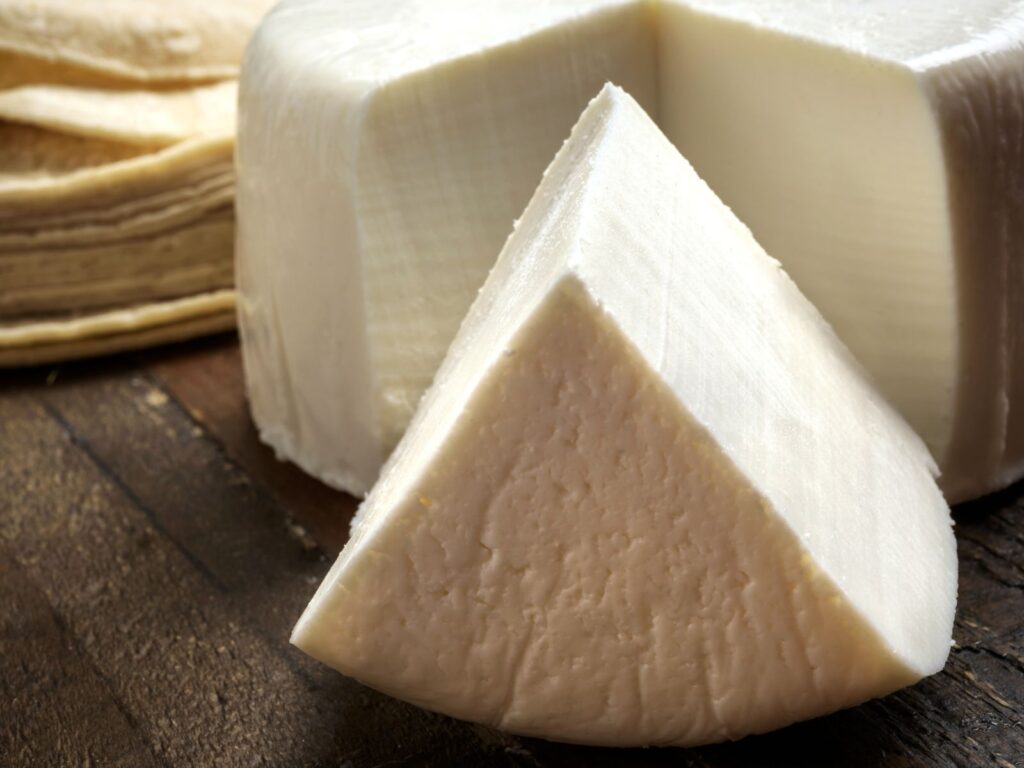
Queso Fresco is a Mexican cheese that has a crumbly texture and a mild, slightly tangy flavour. Also known as Queso Blanco, this unaged cow’s milk cheese is ubiquitous all over the country.
The cheese is believed to have originated in the central region of Mexico. Because its production is quite straight forward, the locals often home-make their own Queso Fresco. Indeed, they use vinegar to coagulate fresh milk and hang the resulting curds in cheesecloths to drain.
Undoubtedly, Queso Fresco is a versatile cheese that can be used in a variety of Mexican and Tex-Mex recipes. Indeed, it is a common ingredient in Enchiladas, Empanadas, Soups and Salads.
2 Cotija (Marca Colectiva)

Next, we have Mexico’s most celebrated hard cheese. Cotija is a hard, crumbly cow’s milk cheese that is similar in texture and flavour to Parmesan cheese. Actually, the cheese gets its name from the town of Cotija in the state of Michoacán, Mexico where it originated. And it is protected by a Marca Colectiva stamp.
Cotija cheese is commonly used in Mexican cuisine, particularly as a topping for dishes such as Tacos, Tostadas and Nachos. There are two types of Cotija cheese available: Cotija Fresco, which is a younger cheese with a milder flavour and crumbly texture.
And Cotija Añejo, which is aged longer and has a more complex flavour and firmer texture.
3 Oaxaca (locally known as Quesillo)
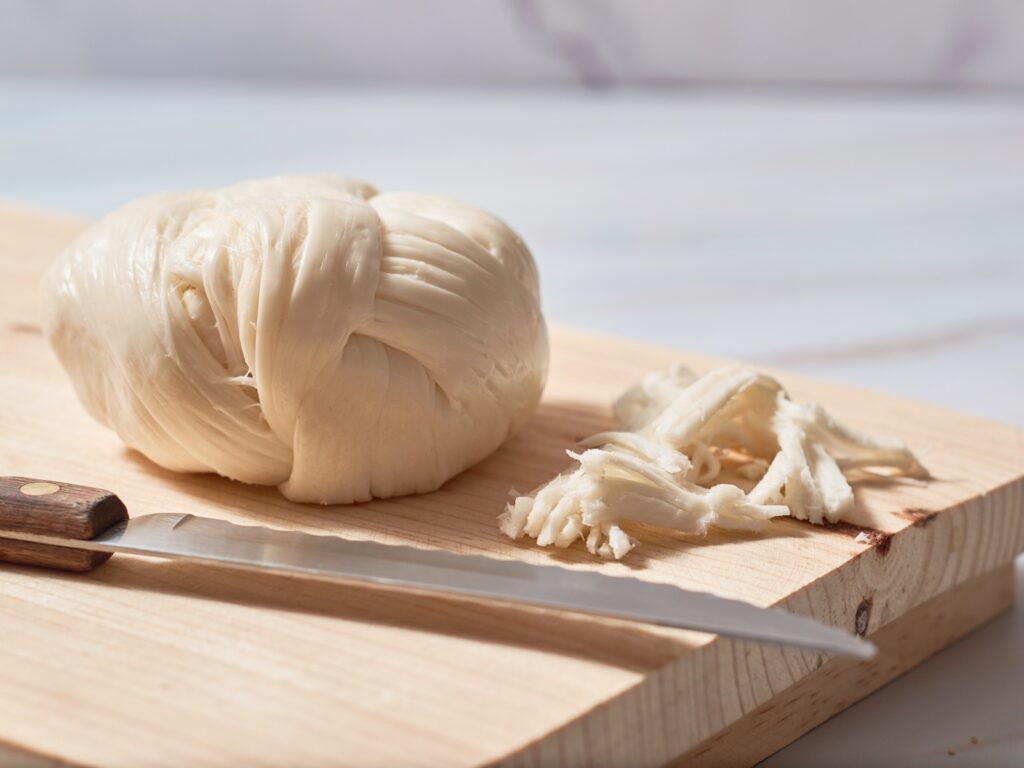
Our third popular Mexican cheese on the list is Oaxaca. Also known as Quesillo (little cheese), this pasta filata cheese originates from the Oaxaca region of Mexico. As a matter of fact, Dominican monks from Italy originally brought its recipe to Oaxaca. Since they couldn’t find buffalo milk in the region, they started using cow’s milk instead.
Oaxaca cheese has a mild and slightly tangy flavour, with a creamy, buttery taste that is similar to Mozzarella. Furthermore, its texture is unique and distinctive, with long, thin strands of cheese that separate when pulled apart.
This cheese is often used in dishes such as Quesadillas, Nachos and Tacos. And it is also a popular ingredient in traditional Mexican soups and stews.
4 Panela

The fourth cheese on our list is a fresh, crumbly cheese made from cow’s milk and is a staple in Mexican cuisine. Its name comes from the Spanish word “panela,” which refers to the type of bread basket in which the cheese was traditionally moulded.
Panela has a slightly sweet and nutty flavour, with a texture similar to firm tofu or Paneer. It is commonly used in nopal salads and regional versions of Guacamole. Moreover, the locals like to grill or fry this cheese because it does not melt easily and retains its shape.
In recent years, there has been an increase in artisanal production of Panela cheese, with small-scale producers focusing on quality and traditional methods.
5 Queso Chihuahua

Queso Chihuahua, also known as Queso Menonita, is a popular cheese in Mexico that originated in the state of Chihuahua.
The history of Queso Chihuahua dates back to the arrival of Mennonite immigrants in Chihuahua in the 1920s. They brought with them their traditional cheesemaking techniques and adapted them to the local resources, including the milk of the local cattle.
The cheese is made from pasteurised cow’s milk and has a pale-yellow colour. Furthermore, its texture is smooth and slightly elastic, making it great for melting. As a result, Queso Chihuahua is often present in dishes like Quesadillas, Enchiladas and Chile Relleno.
6 Queso de Poro (Marca Colectiva)
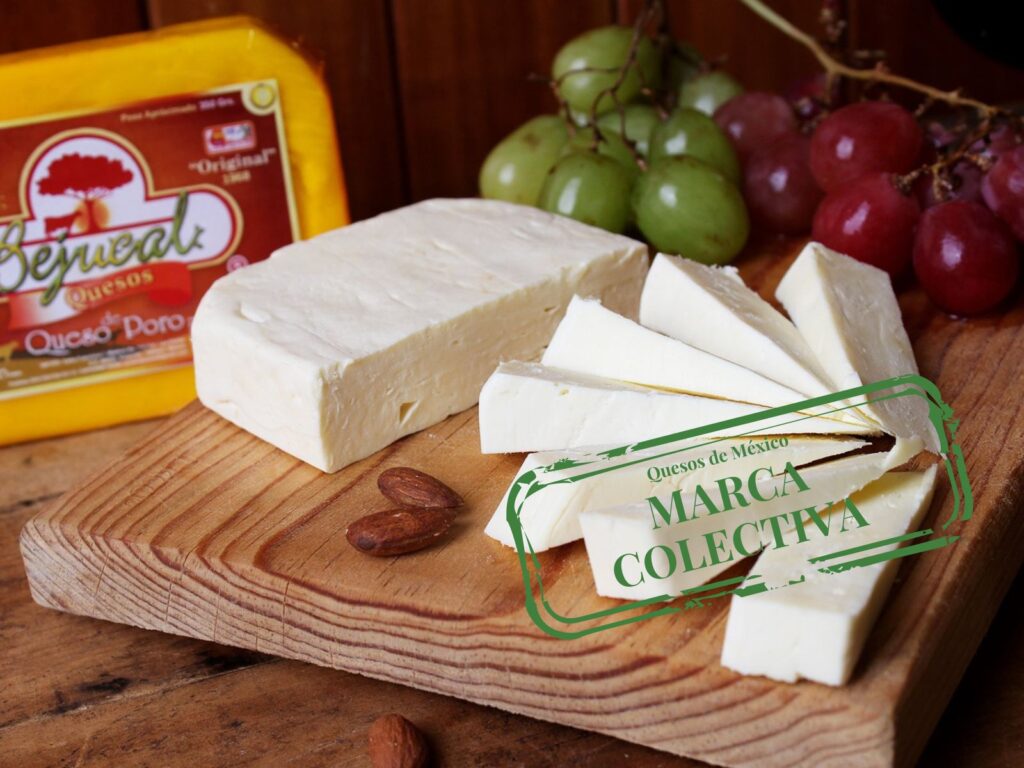
In recent times, artisanal cheese has become increasingly popular in Mexico due to its natural, handcrafted production process. And one such cheese is Queso de Poro.
Originating from Balancán in the Tabasco region, this cheese has a unique flavour and is made using traditional methods passed down through generations. The cheese gets its name from the holes (or poros) that appear in its paste.
To make Queso de Poro, local artisans inoculate fresh cow’s milk with whey from the previous day’s production. After coagulation, they press and salt each cheese. Once they have formed the cheese, they cover each one in paraffin and yellow cellophane to prevent dehydration and mould growth.
As a result, Queso de Poro has a soft, slightly moist paste with an intense aroma and acid-salty flavour. It is often enjoyed with red wine, beer or coffee. And the locals often use it in dishes such as Tortilla Rellena de Mariscos (seafood tortillas).
7 Asadero

Asadero is a traditional Mexican cheese that has been produced for centuries. It originated in the northern state of Chihuahua, which is known for its cattle ranches and dairy farms. Asadero is a semi-soft, white cheese with a smooth texture that makes it perfect for grilling.
This is not surprising since its name translates to “Grilling Cheese” in English.
Overall, Asadero has a mild and slightly sweet flavour, with a hint of tanginess that gives it a unique taste. Asadero cheese is a popular ingredient in Mexican cuisine, especially in dishes such as Quesadillas, Nachos and Chile Relleno (stuffed peppers).
8 Queso de Ocosingo (Marca Colectiva)

Queso de Ocosingo is a hard ball-shaped cheese that hails from Ocosingo in the Chiapas region. Due to its shape, the locals also call this cheese Queso de Bola. The cheese is aged for several months and has a hard rind. Effectively, the rind protects the cheese’s paste from warm and humid climate of the Lacandona Jungle in Ocosingo.
As it ages, the cheese develops a slightly sour and salty taste with sweet notes. As a result, it is a popular ingredient in a number of regional dishes. Actually, the locals often crumble its creamy paste or grate its hard rind into dishes such as Frijoles Refritos and Queso Relleno.
In addition to this, Queso de Ocosingo pairs well with white wine with mineral notes or light beer. And it can be accompanied by peaches for an interesting contrast.
9 Queso Doble Crema (Marca Colectiva)
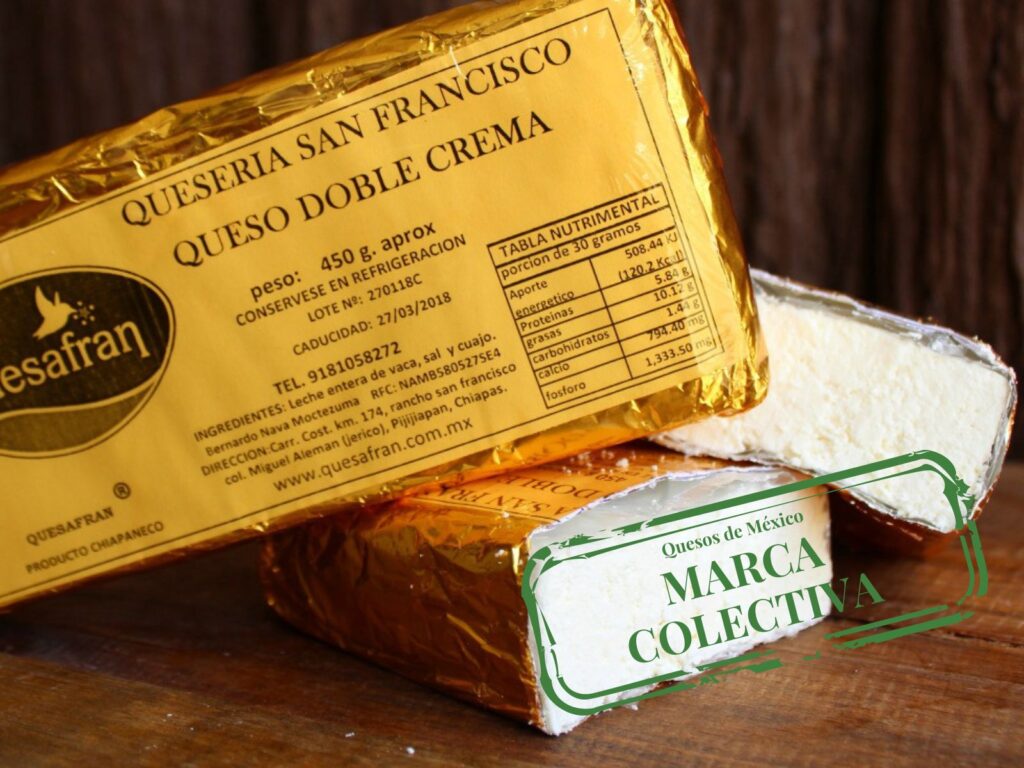
Our second cheese from Chiapas is Queso Doble Crema. As we mentioned above, this is the fourth cheese to bear a stamp of protection in Mexico. Queso Doble Crema (Double Cream Cheese in English) is a handcrafted cheese that has been produced in the state of Chiapas for over 60 years.
It is made using raw cow’s milk and an acidification process that results in a creamy and fresh-flavoured cheese with a texture similar to goat cheese.
Due to its high-fat content, it is a popular addition to Mexican dishes such as Chile Relleno and Enchiladas. If you’re look for extra decadence, there is a triple cream version of this cheese that is sold locally.
10 Requesón

Requesón is a traditional Mexican cheese that is soft and creamy in texture with a slightly tangy taste. The cheese is made by curdling milk with lemon juice or vinegar and then straining it to remove the whey.
It is similar to Italian Ricotta but with a finer texture and creamier taste.
Requesón is a popular ingredient in many traditional Mexican dishes such as Chilaquiles, Enchiladas and Tamales. It can also be served as a spread or dip, and is often mixed with herbs, spices, or fruits for added flavour.
From Asadero to Requesón: A Tour of Mexican Cheeses
Without a doubt, Mexican cheeses are a testament to the country’s rich culinary heritage and diverse geography. From the mild and sweet Queso Asadero to the crumbly and tangy Queso Requesón, Mexican cheeses are an essential ingredient in many of the country’s most beloved dishes.
Some other Mexican cheeses that narrowly missed out on the list include Queso Manchego (not to be confounded with the Spanish one), Queso Reata and Queso Tetilla de Rosamorada.
What’s your favourite Mexican cheese to cook with? Let me know in the comments below.
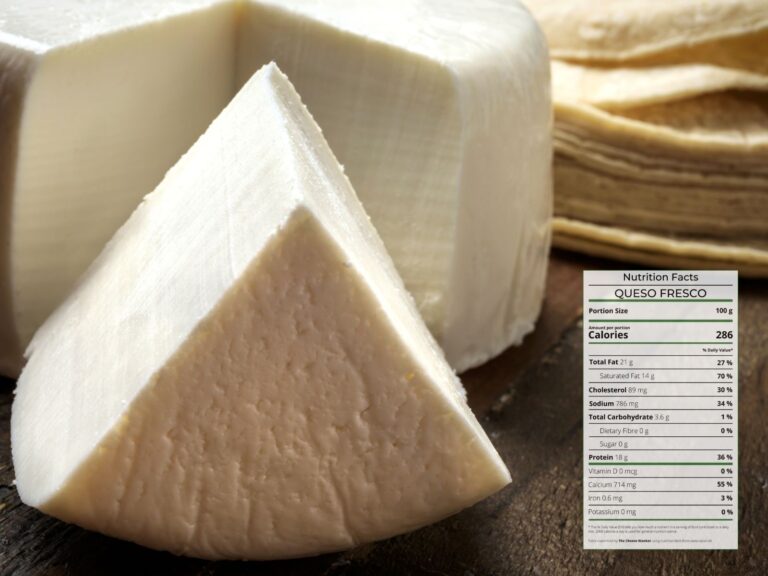
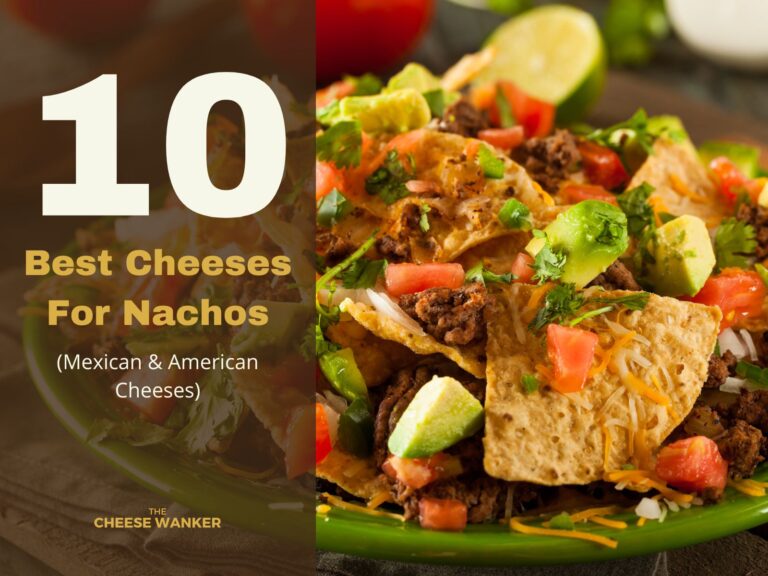
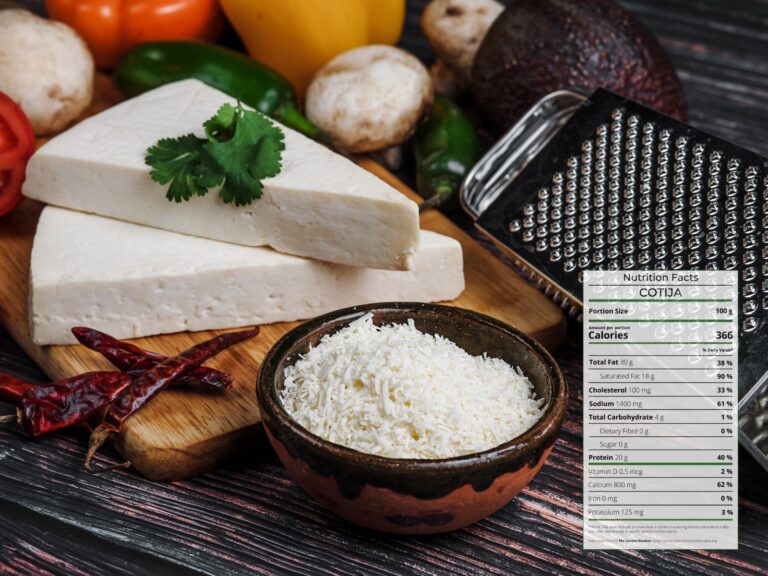
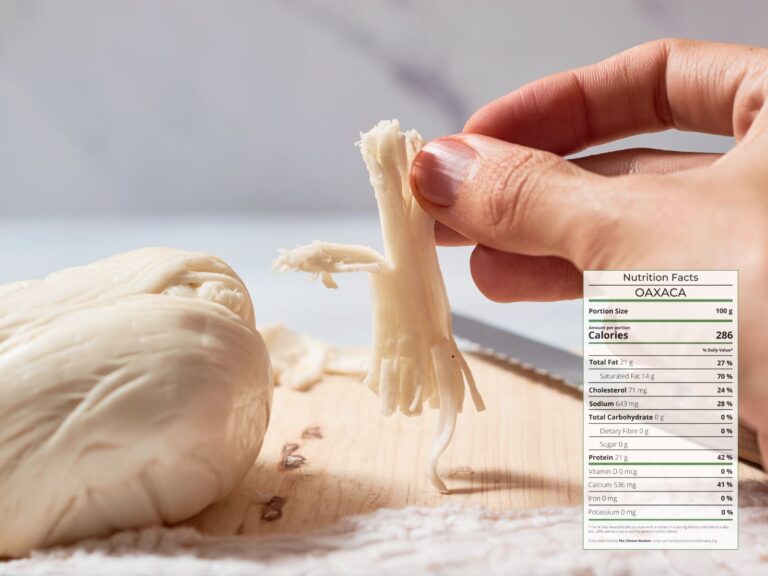
Just incredible